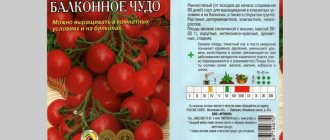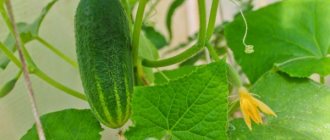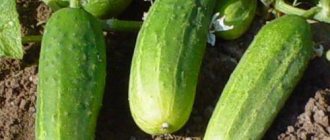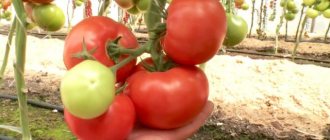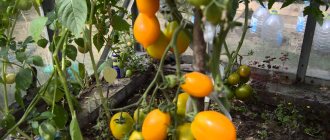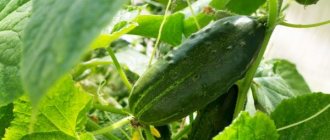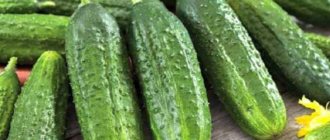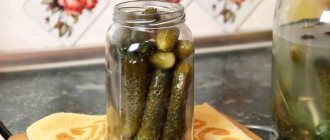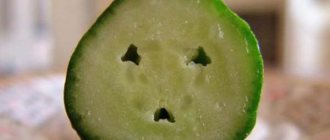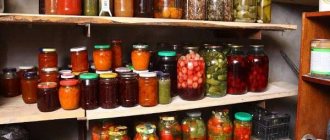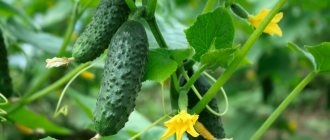Seedling
It is most convenient to sow seeds in peat tablets and then transplant the seedlings into pots.
Immediately before sowing, washers or pots should be generously shed with a solution of calcium nitrate (0.05%) for better growth and development of the root system of young plants. Seeds are sown to a depth of 1.5–2.0 cm and covered with film. The optimal temperature for cucumber germination is 22–24 °C, and it is advisable to keep the pots warm (24–26 °C) until germination. As soon as the seedlings appear on the surface, the film should be immediately removed and, to prevent stretching, they should be moved for three days to a cooler place (+18 ... +19 °C). In the future, it is advisable to establish the following maintenance regime: during the day on a sunny day +20 ... +21 °C, in cloudy weather +19 ... +20 °C, at night +18 ... +19 °C. Higher temperatures will cause young plants to stretch out. The lighting must be good.
Free tomatoes. How to grow tomatoes outside
How to plant?
Cucumbers are grown from seedlings or seeds. Seedlings are grown in peat cups so that when planted in the ground, they do not injure the root system. The seeds need to be prepared.
They are treated with a solution of potassium permanganate or Fitosporin. To make plant development more efficient and occur in a short time, growth stimulants such as Zircon and Epin are used.
The seeds are pre-germinated. For this, wet sawdust is used. They are moistened with water, ash solution or Fitosporin. After 5 days, the seeds swell and begin to hatch. They can be planted. The soil should be soft, moist and warm.
The optimal soil temperature is 18 C. The seedlings are deepened by 5 cm and sprinkled with soil mixture or sawdust. After 14 days, shoots appear. When using growth stimulants, sprouts appear within a week.
The peat cups in which the seedlings are planted are covered with film to create a greenhouse effect. It must be raised daily to ventilate the soil. No watering required. The temperature in the room is maintained at up to 30 C. When sprouts appear, the regime is changed.
The temperature is gradually reduced to 25 C. Lighting is provided for seedlings; use fluorescent lamps. The optimal daylight hours are 16 hours.
The seedlings are watered once a week with warm water. Once every 2 weeks you can use “Potassium humates”. If the seedlings are very elongated, then the temperature in the room is reduced to 22 C, daylight hours are reduced to 8 hours. Before planting in the ground, the seedlings must be adapted to new conditions.
It is taken out into an open area, into a greenhouse or onto a balcony. Plants are transplanted to a permanent growing location after 40 days. When using growth stimulants, planting is carried out after a month.
Consumer qualities
The fruits are small in size, gherkin type. The length of the greens at technical ripeness is no more than 12 cm; fruit diameter is 2-2.5 cm. Even overripe cucumbers do not become large and do not form hard seeds. It is recommended to collect greens daily: this promotes the growth of the following ovaries in the hand.
The skin of a young cucumber is not too dense and is practically not felt when eating the fruit. Nevertheless, it is quite strong, allowing cucumbers not to lose their elasticity and presentation for several days. Cucumbers are quite transportable; Store in the refrigerator for several days.
The color of the skin is green; at the tip there is a small light area, from which several parallel stripes of a yellowish-white hue extend to the base. There are not too many tubercles; As the fetus grows, they become rare and inconspicuous. The spines are white and blunt.
The pulp is dense, crispy, greenish in color. The walls of the fruit are not particularly thick; it is filled with seed capsules to ¾ of the diameter. The grains in the capsules are formed in small quantities, and the taste of the cucumbers does not suffer. The characteristics and descriptions of the variety given by amateur vegetable growers note a pleasant cucumber aroma, moderately pronounced and unobtrusive. The taste is sweetish, delicate, the consistency of the fruit is juicy.
The main purpose of the early variety is to consume fresh vegetables. Small, crispy and tender greens are a pleasant addition to any salads. They can be used for gourmet cuts and gourmet snacks. Cucumber slices are included in sandwiches, rolls, and national dishes. Cold summer soups (okroshka, kuksi) and even refreshing drinks are prepared from fresh cucumbers.
Cucumbers can be stored for a long time by cold pickling some of the products. Lightly salted vegetables are always popular as an excellent snack and addition to potato dishes.
If you have a large number of gherkins, you can also prepare them for winter storage. Traditionally, small fruits are included in assorted vegetables or salted and pickled separately. Somewhat overgrown vegetables can be preserved in cut form or made into pickles, salads and snacks. Cucumbers can even be stored frozen so that you can enjoy okroshka in the winter.
Before freezing, the fruits must be cut into strips and placed in bags.
Landing
Plants need to be planted in warm soil
The best time to plant in open ground is the beginning of May, when the ground is already quite well warmed up.
The soil in the hole should be soft and rich in nutrients. The bed for cucumbers should be prepared in advance. The optimal distance between plants is 30 cm in greenhouses and 20 cm in open ground. The row spacing should be 40 cm.
For cultivation, you can also use flowerpots and deep boxes with a double bottom. When growing cucumbers of this variety on the balcony, you should provide one plant with a capacity of at least 6 liters. Soil acidity must be maintained within 6.8 units.
How to place seedlings on the balcony?
In order for the plants to grow strong with a good harvest, you should pay attention to the location of the seedlings. It is best to place them at a distance of approximately 45-50 cm from each other. You should not place them in several rows, it is better in one row. If the seeds were sown in a box, then its height should not be less than 40 cm for tomatoes and 20 cm for cucumbers.
These vegetable crops can be planted directly from seeds or seedlings, but the second option is more preferable. It is easier for him to create good lighting during the preparation period and you can immediately see which plants will take root and which will not. The average age of tomato seedlings is 45 days, and cucumbers 30 days (for example, balcony miracle cucumber f1).
There are exceptions, but this applies more to early ripening varieties.
To prevent the side shoots of cherry or other varieties from growing too much, they are broken off.
The formation of tomatoes should occur in one stem. If one of the seedlings suddenly begins to lag significantly in growth or die, you can help it by sending one of the stepsons to this area. As soon as the seedlings grow taller, they should be tied to supports made of wooden slats or specially purchased in the store.
How to plant
The pot for one cucumber plant must be voluminous - at least 5 liters. Containers with a double bottom are convenient to use. Cucumbers need a loose substrate for planting - lack of oxygen has a detrimental effect on the growth and development of plants
When using ready-made soil, pay attention to its acidity (pH – 6.5–6.8). To better retain moisture in the ground, you can add hydrogel to it.
Pots should be filled without filling 5–6 cm to the top edge. As the soil in the containers shrinks, it should be added to the previous level. It should be remembered that cucumbers consume a large amount of water, and their roots do not like cold douches. Therefore, water regularly and always with warm (22–24 °C) water.
Care
Growing City Cucumber F1 is not difficult. Cucumber seeds of this variety are sown in a hole. It makes no sense to grow them in seedlings. Seeds are sown only after hatching.
Plant care involves:
- timely and abundant watering;
- root and foliar feeding;
- insecticide treatment.
When the plant reaches a height of 2 m, it is recommended to pinch the top. Thanks to this, the cucumber produces side shoots with a large amount of ovary after forcing the first leaf. The spreading nature of the City Cucumber bush forces gardeners to tie it up. The best option is to use a horizontal trellis.
Description of cucumbers Balcony miracle F1
One of the most successful varieties for balcony cultivation is the parthenocarpic (self-pollinating) hybrid F1 “Balcony Miracle”. This plant is compact, its stem is long, the leaves are small, and the root system is well developed. Its internodes are short, there are many nodes, each of them can hold up to three dozen cucumbers. Zelentsy are small, gherkin-type (up to 8 cm in size, weighing up to 60 g), cylindrical in shape, bright green, with small tubercles. They have a sweetish, pleasant taste without bitterness. This variety is early: the greens begin to ripen within a month and a half after the first leaves appear.
Its main advantages:
- excellent taste both fresh and canned;
- high drought resistance and shade tolerance;
- precocity;
- good resistance to many diseases (powdery mildew, cucumber mosaic, etc.);
- high productivity;
- self-pollinating;
- Possibility of growing both in open ground and in small areas in pots or cache-pots.
Being a first-generation hybrid, this cucumber variety does not produce productive seeds that inherit parental characteristics.
Description of the variety
F1 Balcony cucumber is a hybrid obtained by crossing two varieties of cucumbers. The vegetable of this variety has a sweetish taste and does not contain bitterness. Self-pollinating, parthenocarpic.
- It has a female type of flowering.
- The productivity of this variety is excellent, reaching up to 9 kg m2.
- The hybrid grows in partial shade and does not require much lighting.
The cucumber is medium-sized, weakly climbing. The root system allows you to grow it at home, which is very convenient for the balcony. The hybrid is also suitable for growing in open and closed ground, and cucumbers also grow well even in a window.
This type of vegetable crop is very easy to care for, resistant to dry weather and cucumber diseases. There is no need to treat it with chemicals, and you can grow an environmentally friendly crop without much hassle.
Do you think cucumbers grown on the balcony are tastier than those grown in open ground?
Not really
Cucumber care
Caring for the “Balcony Miracle F1” is as follows:
- Garter. Cucumber is a climbing plant that needs support. For normal growth, a wire is pulled at a height of up to 170 cm from the ground. A twine is tied to it, twisting its lower end around the plant. Thereby directing the latter to movement along the support.
- Pinching. To ensure that the “Balcony Miracle” has one stem, does not branch and does not thicken, its tendrils and side shoots are removed. For the remaining shoots that have grown to the wire, only one leaf is left above the ovary.
- Feeding. During the fruiting period, plants need nutrition every ten days with mineral fertilizers and organic substances - wood ash, infusions of eggshells or tea.
- Watering at the root is carried out at least 2-3 times a week, using settled, not cold water.
Rules for further care
The balcony miracle will not require too much attention from the gardener, but for abundant fruiting, you need to follow a few simple rules:
- Water the plantings only with settled cool water and at the roots. Sprinkling cannot be carried out. When drops of water get into the leaf axil, rot forms, and the leaves burn out from the sun. When growing a hybrid at a summer cottage, drip irrigation is installed. This system is very convenient, since water goes directly to the roots, and its consumption will be minimal;
- weed the soil to remove weeds and loosen the soil. Good air exchange is necessary for the normal development of bushes;
- The plantings are fed with organic or mineral fertilizers for the active formation of ovaries. Fertilizing is applied no more than 3-4 times with an interval of 7-10 days and always in moist soil;
- tie the main vines to a trellis or any other support as soon as they have reached a length of 30-40 cm. This will help relieve the load on the bushes, and the fruits will ripen evenly on all sides;
- form a bush. When the side lashes reach a length of 50 cm, they are pinched.
The first fragrant cucumbers appear approximately 6 weeks from the start of cultivation, and the main fruit harvest begins another week later. During ripening, the fruits are harvested every 2 days, and if fruiting is abundant, you need to pick the greens every day. Regular harvesting of fruits helps to quickly form new ovaries.
Note! Avid gardeners plant the seeds of the Balcony Miracle 2 months before the New Year so that they can enjoy fresh homemade cucumbers for the holiday.
Transplanting seedlings
When two leaves appear on young plants, this means that the seedlings are ready to be transplanted to a permanent location. For central Russia, this period falls in the second half of spring. Transplantation requires compliance with the following rules:
- For each plant you should prepare a container with a volume of 5-8 liters. These can be plastic bottles with a cut off top, ceramic pots, flower boxes, or even bags in which ready-made earthen mixtures are sold.
- Expanded clay, crushed stone or small pebbles are placed at the bottom of these containers, equipped with drainage holes.
- It is necessary to fill them with soil not to the brim, but to provide for the possibility of further adding soil in case the roots of the plant are exposed.
- The composition of the soil should be similar to that in which the seeds were planted. Before planting, water the soil with warm water with the addition of a small amount of potassium permanganate.
- Plants are planted, trying to preserve the earthen ball with roots as much as possible.
Step-by-step instructions for those who want to grow cucumbers in plastic bottles
1.5-liter bottles are cut crosswise, 5-liter bottles are cut lengthwise or crosswise. If everything is clear with a longitudinal section - you get two oblong containers, then regarding the cross section, expert opinions are divided. Disputes arise regarding exactly which part will be used as containers for plants.
There are two options for effectively using 5-liter plastic bottles cut crosswise:
- The lower part of the bottle is used as a pot, and the upper part protects heat-loving seedlings from cold air and precipitation. To prevent water from stagnating inside the plastic container, the bottom of the bottle is pierced in several places. This measure provides for the presence of another vessel designed to collect water, the diameter of which is wider than the diameter of the plastic structure;
- The upper part is used for growing cucumbers, and the lower part acts as a tray. A little water is poured into the bottom of the cut bottle. Remove the cap from the top of the bottle, in which the seedlings are already planted, and then place it in the tray with the neck down. This way the seedlings will have access to water.
Planting balcony cucumbers can be done at any time of the year. Winter planting implies that the development of plants will take place on a glazed, well-lit and heated balcony.
Some vegetable growers who prefer to grow cucumbers in winter neglect recommendations for lighting containers with seedlings. Deviating from the methodology can lead to unpleasant consequences.
When there is insufficient lighting, young shoots stretch towards the source of light coming from a lamp illuminating a neighboring balcony, lighting coming from a room adjacent to the balcony, or the meager rays of the winter sun. In most cases, the cause of seedling death is an overly elongated trunk.
The situation can be corrected if you listen to the tips offered below:
- Increase lighting . To accomplish this task, you can, for example, install ultraviolet lamps above the seedling box, the glow of which is very similar to the light emitted by the sun's rays. Alternatively, in sunny weather, seedling boxes are placed so that they are in the light distribution zone. It is advisable that the duration of sunbathing lasts at least 8 hours a day, with the exception of the night period.
- Stimulate root development . To slow down the growth of the stem, increase the amount of soil. As a result, the development of the plant’s root system is activated, and, consequently, the development of the stem will be temporarily stopped.
- Thin out . Among the possible reasons for the elongation of seedling stems is an excessively high density of seedlings. The seedlings are either dug up or planted so that each of them receives at least 11 tablespoons of soil. Many vegetable growers, noticing that the stems of the sprouts have stretched out, immediately begin to transplant the sprouts into separate containers. This step is very important, since when the formed bushes are planted in permanent pots, their root system will be practically undamaged.
- Feed . The reason for the stems to stretch may be a lack of nutrients. However, fertilizing with potassium fertilizers may not be enough. Experienced vegetable growers water the soil with an ash solution. A tablespoon of ash (preferably birch) is poured into a glass of clean water and left for several minutes. Ash can be replaced with drugs that increase the immunity of vegetables.
Characteristics of the variety
The length of the Balcony Miracle variety reaches up to 1.5 meters. During growth, its side shoots are formed, which need to be pinched.
- The leaves of the hybrid are bright green and small.
- 2-3 ovaries are formed in each node. the variety is mid-season.
- Productivity occurs 50 days after sowing the seeds.
You can take a sample approximately 10 days after the due date, and you will also be interested in knowing:
- That this hybrid plant is related to gherkins.
- The average length of cucumbers reaches 7-8 cm, weight - 60 g. The fruits of the hybrid are cylindrical in shape, with a tuberculate surface.
- The vegetable has a pleasant taste and a bright aroma. The pulp is sweetish, medium density. Cucumber is characterized by crunch and freshness. The vegetable is good for salads and also for canning.
- The balcony miracle is not picky in terms of cultivation. Even cultivation in apartment conditions is not particularly difficult if you follow some rules.
- The variety can also be grown in the traditional way in garden beds. This plant loves heat very much and does not tolerate temperatures of +15 degrees.
Lukhovitsk cucumbers are famous throughout Russia. In this article you can find out.
Diseases and pests
The hybrid variety “Balcony Miracle” is resistant to the following diseases: radiant dew, cucumber mosaic, and other pathologies; they do not need to be treated with chemicals during cultivation.
The photographs below will allow you to take a closer look at the Balcony Miracle variety, which can often be seen on cucumbers on the balcony.
Features of cultivation and care
Depending on where the crop will grow, cucumbers are sown in peat pots or a bed. To grow at home, seeds are planted in pots, flowerpots, and containers. The container must have holes for water drainage, a double bottom or a tray. Most of the containers are filled with loose, disinfected substrate. During the growing season of cucumbers, as the soil compacts, it is added to the initial level.
To ensure that the bush has enough nutrition and the soil does not dry out, you need to plant the plants in a container of at least 5 liters.
When the temperature outside the window rises to +24–+26 ⁰С, cucumber seeds are planted in pots to a depth of 1.5–2 cm and placed on an eastern or south-eastern window sill. To prevent the soil from drying out, cover the container with glass. When it is not yet warm enough outside, you can grow cucumbers using seedlings.
See also
Instructions for use on how to treat cucumbers with Fitoverm
After the sprouts of the hybrid variety appear, the temperature is kept at +20–+24 ⁰C during the day, and 18–19 ⁰C at night. Moderate temperatures will prevent cucumber sprouts from stretching. The optimal volume of a pot for growing seedlings is 200–300 ml. Growing cucumbers in a smaller container is problematic, since the soil will often dry out. The root system does not have time to weave a lot of substrate, which is why the shoots may be damaged during manipulation and the plant will not take root.
At the age of 2 and 3 true leaves, seedlings are fed with water-soluble fertilizers based on the calculation of 2–3 g per 1 liter of water. You can plant cucumbers on an insulated balcony from May 1 to 5, and on an open balcony from 10 to 15. The age of the seedlings at the time of transplanting to a permanent place should be 10–20 days.
You can grow indoor cucumbers only if they are properly tied. As a support, strings are used, attached to the top of the balcony and mobile U-shaped supports, which are installed in each pot. Cucumbers are also grown in hanging pots.
To ensure that the characteristics correspond to reality, cucumbers are formed according to the following scheme:
- On the lower 2–3 nodes, the ovaries and lateral processes are plucked off.
- At the next pair of nodes, the ovaries are left and the shoots are removed.
- The remaining shoots are first pinched into 2 leaves, and then into 3–4.
- At the end of the trellis, the top is pinched off or the stem is wrapped around the support and pinched off at the bottom.
Growing balcony cucumbers in plastic bottles
In most cases, cucumbers are grown in five-liter bottles. In them, the root system of the plant feels comfortable, and the plant itself bears fruit better. First of all, the vegetable grower must take care of the quality of the soil and choose a place for a plastic “mini-bed”.
Characteristics of the variety
According to the description, City Cucumber F1 is one of the hybrids intended for growing in open beds, in greenhouses and even indoors.
The variety is capable of self-pollination, which increases its yield and allows the formation of ovaries without additional pollination.
The flowers on plants of this hybrid are collected in inflorescences, which is why they are called bunched. The City Cucumber variety is high-yielding: up to 3 kg of fruits are obtained from 1 bush per season.
Peculiarities
The advantages of the City Cucumber include:
- good seed germination;
- early ripeness;
- duration of the fruiting period.
No more than 40 days pass from germination to the start of harvesting the first harvest of the fruits of this hybrid. This cucumber is valued because it never bears empty flowers. The hybrid is drought-resistant and shade-tolerant.
In open ground conditions, the bushes bear fruit when a stable temperature is established: 15°C at night and above 24°C during the day. The optimal temperature for growing City Cucumber is 25°C. Air humidity in artificial conditions should be maintained at 70%.
Description of the bush
The plant is highly branched and covered with dense green leaves. The size of the latter varies from small to medium, but there is a lot of foliage, so the bush seems huge. A multiple ovary is formed in the axil of each leaf: the number of buds in it ranges from 3 to 10 pieces.
A feature of the cultivation of this variety is the need for timely harvesting. The more often the collection is carried out, the more buds will appear on the shoots, and the branches themselves will begin to grow much more actively.
The cucumber root system is well developed. If the bush will be grown on the balcony or right in the room, then it would be best to place the pot with the plant on the south-east window. In this case, the shoots grow evenly, and the ovary on them becomes frequent.
Description of the fruit
The fruits of the hybrid City Cucumber F1 belong to the finger varieties of cucumbers and have a regular oval shape.
The weight of one fruit usually does not exceed 90 g. The maximum length of the gherkin is 12 cm, and the diameter is 3 cm. Mature gherkins are green in color with longitudinal whitish stripes along the edges. The latter are not clearly expressed. When cut, the fruits have white, juicy pulp with small grains; there are no internal cavities (voids).
Cucumbers of the Urban cucumber variety are distinguished by moderate density and soft, slightly pubescent spines. The fruits are attached to the bush on long thin stalks, which allows the crop to remain miniature for a long time after ripening.
Fresh cucumbers never taste bitter, and the taste of pickled preparations is also high. When canned, the fruits turn out crispy and moderately dense.
Plants of this variety, with proper care, bear fruit until frost.
What varieties are best to plant?
As a rule, most cucumber varieties require cross-pollination. Agronomists recommend planting short-fruited varieties on the balcony and performing a similar procedure using a brush. To do this, pollen is carefully transferred from a flower that does not have an ovary to a flower that already has an ovary.
If you don’t want to do extra work, pay attention to parthenocarpic options. They don't need to be pollinated, they do it themselves.
One of the best are “Balcony Miracle” cucumbers, which are several times superior to standard varieties of cucumbers. It produces a rich, bountiful harvest and does not need much light in winter and spring. Greens are suitable for salads; they are dark green in color and medium in length. Also popular is the F1 balcony window, which is characterized by its high productivity.
Cucumbers “Balcony Miracle”
In the period from March to April, it is recommended to plant hybrids “Malachite”, “Stella”, “Moscow Greenhouse” and “Zozulya” (TSHA-77). Their advantage is a pronounced salad taste, high yield per plant and the appearance of ovaries without pollination. In order to increase air humidity to a normal level, the leaves are sprayed with warm water.
Read more in the article “Cucumbers on the balcony.”
As for tomatoes, the best option is considered to be early-ripening cherry varieties intended for the greenhouse. For example, “Siberian early ripening”, “Verlioka”, “Nevsky” and “White filling”. In this case, the harvest will appear much earlier than when growing ordinary tomatoes, but you need to be prepared for the fact that the fruits will not be very large.
Tomatoes “Siberian early ripening”
When growing cherry tomatoes on the balcony, give preference to low-growing (standard) varieties. These are “Pearl”, “Tiny Tim”, “Angelica”, “Florida Petit”, “Oak”, “Baby”, “Room Surprise”, “Balcony Miracle” tomatoes. Among tall tomatoes, the leading positions are occupied by “White filling” and “Bull’s heart”. They can be grown if a large container is selected for them and the balcony is spacious enough.
Characteristics of balcony cucumber varieties
F1 BALCONY
parthenocarpic bunched gherkin of female flowering type. Branching is average. From 2-4 to 6-8 or more ovaries are formed in the nodes, the filling of the ovaries in the node is consistent. The greens are lumpy, white-thorned, 6-10 cm long, and do not outgrow for a long time. The pickling and taste qualities are high. The hybrid is resistant to olive spot, common cucumber mosaic virus, powdery mildew, and tolerant to downy mildew.
F1 CITY CUCUMBER
Parthenocarpic bunched gherkin. Branching is active. It begins to bear fruit 40-41 days after germination. An average of 3-9 or more ovaries are formed in the nodes. The greens are tuberculate, white-thorned, 9-12 cm long, weighing 75-90 cm, on a long stalk. Zelentsy do not outgrow for a long time; remain small and thin (“finger cucumbers”) for a long time. The hybrid amazes with an abundance of greens on the plant for a long time. Due to its increased shade tolerance, it is suitable for cultivation on the windowsill. Resistant to olive spot, cucumber mosaic virus, powdery mildew, tolerant to downy mildew.
F1 SHOW
Early ripening parthenocarpic gherkin bunch hybrid of predominantly female or female flowering type. Branching is weak; side shoots are short. From 2-3 to 4-6 ovaries are formed in the nodes. The greens are tuberculate, oval-spindle-shaped, intense green in color with longitudinal light stripes, short, 8-10 cm long, weighing 80-90 g. The taste and pickling qualities are high. The hybrid is resistant to olive spot, common cucumber mosaic, powdery mildew, and tolerant to downy mildew.
F1 CALENDAR
An early ripening parthenocarpic gherkin hybrid of a female or predominantly female type of flowering with a bunch arrangement of ovaries in the nodes. Branching is average. From 2-3 to 5-6 ovaries are formed in the nodes; on the side shoots the bunching is more pronounced than on the main shoot. The greens are tuberculate, oval-spindle-shaped, intense green in color with longitudinal light stripes, short, 8-10 cm long, weighing 80-90 g. The taste and pickling qualities are high. The hybrid is resistant to olive spot, common cucumber mosaic, powdery mildew, and tolerant to downy mildew.
F1 HUMMINGBRI
Early ripening parthenocarpic bunch gherkin hybrid of female or predominantly female type of flowering. From 2 to 8-10 ovaries are formed in the nodes. Zelentsy are short, tuberculate, white-thorned, 5-8 cm long, weighing 60-80 g, spindle-shaped, on a long stalk. On the surface of greens there are short light longitudinal stripes. The taste and pickling qualities are high. The hybrid is resistant to olive spot, common cucumber mosaic, powdery mildew, and tolerant to downy mildew.
F1 Swallowtail
Early ripening parthenocarpic bunch gherkin hybrid of female or predominantly female type of flowering. From 2 to 7-11 ovaries are formed at the nodes of the stem and side shoots. Zelentsy are short, tuberculate, white-thorned, spindle-shaped, 7-11 cm long, weighing 60-110 g. The surface of greens is characterized by short light longitudinal stripes. The taste and pickling qualities are high. The hybrid is resistant to olive spot, common cucumber mosaic, powdery mildew, and tolerant to downy mildew.
Read about other varieties of cucumber in the articles:
Cucumber: how to choose the right variety
Spring-summer varieties of cucumber. Parthenocarpic bunch gherkin hybrids
Spring-summer varieties of cucumber. Parthenocarpic tuberculate and smooth-fruited hybrids
Review of the best self-pollinating varieties and hybrids of cucumbers for the balcony
Specially bred balcony varieties and some hybrids intended for greenhouses are suitable for growing on a windowsill. Let's look at the most popular and well-proven ones.
Hummingbird
This is a gherkin-type hybrid that does not require pollinators. The leaves of the plant are small, the side shoots are short, the internodes are short, and from 3 to 10 ovaries are formed in them. The crop is high-yielding, cucumbers grow tuberculate and white-thorned, spindle-shaped, 5-8 cm long and weighing up to 80 g.
The hybrid has an interesting watermelon color. The first fruits appear already 40 days after planting the seeds. Hummingbird is completely unpretentious in cultivation and tolerates darkening well.
Another advantage is high resistance to many diseases. No pest damage is observed.
Hummingbird is good for canning.
City pickle
If there is very little growing space, the City Cucumber is an ideal option. A very hardy and unpretentious hybrid. Gherkins grow in clusters, with 4 to 10 ovaries in nodes. Fruit length is 10-12 cm, weight is up to 95 g.
The cucumber is early ripening - the fruits ripen already on the 40th day after planting - and very fruitful - they harvest from the bush for a long time.
The urban cucumber is highly resistant to many cucumber diseases. Very tasty, suitable for salads and canning.
Debut
Self-pollinating hybrid, early ripening and high-yielding. Lumpy, cylindrical greens grow up to 12-14 cm in length and weigh up to 100 g. The first cucumbers ripen 45 days after the bushes appear.
The plant is low, with a bunched ovary. It does not require special care and has good disease resistance. Debut is not suitable for canning, but fresh it has excellent taste.
April
Self-pollinating early-ripening hybrid - the fruits begin to ripen on the 45th day of planting the seeds. The plant is low, bushy. The vegetables have large tubercles and white spines, the weight reaches 200-250 g. With good care, up to 15 kg of crop can be harvested from 1 m².
There are also disadvantages: the hybrid is not suitable for winter canning and is not very resistant to cucumber diseases.
Balagan
The hybrid is ideal for growing on a windowsill or balcony. The leaves are medium-sized, do not obscure themselves, the root system is compact, the internodes are short, and have from 3 to 9 ovaries.
Balagan is early ripening - ripening begins at 41 days. The fruits are small, up to 10 cm long and weighing up to 85 g, and do not outgrow for a long time. The hybrid tolerates lack of light and moisture well and is resistant to disease.
Swallowtail
Swallowtails are planted by lovers of large cucumbers. Their length is up to 12 cm, weight - up to 110 g. This is an early-ripening self-pollinating bunch hybrid with short shoots on the sides and internodes, on which up to 11 flowers appear.
Easy to care for and resilient. The excellent taste of Machaon is preserved during canning and pickling.
Calendar
Self-pollinating high-yielding hybrid. It is highly resistant to cucumber infections and has excellent taste. Gherkins are up to 10 cm long and weigh 80-90 g, white-spiked and tuberculate. The calendar is used both fresh and for canning.
Zozulya
The most popular hybrid of cucumbers grown on balconies and plots. In greenhouses, the yield is significantly higher than in open ground plantings.
The plant is small, bushy, cylindrical cucumbers with tubercles 20-22 cm long and an average weight of 220 g. Zozulya is immune to diseases.
Cucumbers are without bitterness and are suitable for fresh consumption and in salads. They are not intended for canning or pickling.
Elegant
The Graceful variety is an early ripening variety. The first fruits are harvested already 40 days after germination. The plant is medium-climbing, forms from 5 to 7 lateral shoots. It is characterized by increased resistance to diseases such as powdery mildew, bacteriosis, and olive spot.
The cucumbers themselves grow up to 14 cm in length and weigh up to 15 g, smooth, with small tubercles. The taste is high. The variety is universal, suitable for salads and canning.
Balcony miracle
The hybrid gives a high yield on the window and has an excellent fruit taste. The plant is weakly climbing and medium-sized, with a compact root system. This makes it possible to grow it even in flower pots and flowerpots.
The Balcony Miracle cucumber is easy to care for, tolerates lack of light well and is resistant to diseases. The fruits are classified as gherkins, grow up to 8 cm in length, weighing about 60 g. Cucumbers have a pleasant taste and bright aroma. Balcony Miracle is consumed in fresh and canned forms.
Growing seedlings
Many gardeners prefer to grow the “Balcony Miracle” using seedlings. Here is an example of step-by-step cultivation of cucumbers:
- When small sprouts appear, the seeds are planted in boxes or containers.
- Use universal or self-prepared soil. In the latter case, garden soil, peat, humus and sawdust are mixed in equal proportions. It is advisable to supplement the mixture with urea and nitrophoska in small quantities: one spoon of each.
- The seeds are buried 2 centimeters into the soil. The distance between them is 40 centimeters.
- In order for cucumber seeds to germinate faster, the boxes need to be covered with film, but with daily ventilation.
- As soon as all the seeds have sprouted, the covering material should be removed.
- Boxes with seedlings are placed in a lighted place in a room where there are no drafts and the air temperature reaches 25 degrees.
- Seedlings are watered daily.
- Young plants are fed for the first time two weeks after planting, and the second time – a week after the first feeding.
- If two seeds sprouted in one hole, the weaker plant is removed.
- When two leaves appear, the plants are pricked up and hardened off by briefly placing the pots in a cooler environment.
- After about three weeks, the cucumber seedlings are transplanted to a permanent place of growth in larger containers (5-8 l) with soil of identical composition. This time usually occurs at the beginning of May.
- To plant seedlings, you can use boxes, peat pots, buckets and even bags. Drainage holes are made at the bottom of the containers and filled with expanded clay or crushed stone (bottom layer). Soil is laid on top.
Hydroponic method of growing cucumbers
The hydroponic method involves growing plants in a nutrient liquid, without using soil. The advantage of the hydroponic method is the ability to get a rich harvest from a small area. Traditionally, the nutrient mixture includes the following chemical elements: N, P, Ca, K, S, Mg, Mo, Cu, Zn, B, Mn, Fe.
To grow cucumbers hydroponically, you need to stock up on:
- a hollow container for the nutrient mixture with holes. The diameter of the holes corresponds to the diameter of the container with seedlings;
- mineral fertilizers;
- compost;
- expanded clay, moss and medium-sized crushed stone;
- containers for plants (disposable sour cream cups or cut-off plastic bottles);
- water.
The bottoms of the containers are first perforated, after which they are filled with a mixture of expanded clay, moss and crushed stone. The filler will serve as soil. Cucumber seedlings are carefully placed on top.
The container with seedlings is placed in a tank filled with a nutrient mixture prepared from water, compost and mineral fertilizers taken in a 3:1:1 ratio. It is necessary to ensure that the upper edge of the root of each seedling can come into contact with air molecules.
Growing
It is better to plant the balcony miracle in open ground at the end of May.
Seed preparation
Pre-treatment of cucumber seeds subsequently affects their yield and viability. Using certain procedures, harmful microorganisms are removed from the top of the seeds, which increases their germination. Seeds must be pre-processed in several stages:
- Warming up the planting material. It needs to be done in the oven at temperatures up to 50 degrees. You can also tie a bag of grains to a hot radiator for 1-2 days.
- Disinfection. To disinfect seeds, they need to be soaked for 2-3 hours in a weak concentration of potassium permanganate solution.
- Germination. For better germination of cucumber seeds, they should be placed in a damp cloth and kept at a temperature of +27 degrees. Full seeds should hatch in a warm, humid environment within 2-3 days, after which they can be planted in the ground.
Warming up the planting material increases the number of female flowers, and, consequently, the yield.
Growing seedlings
To sow cucumber seedling material, you need to take a container and soil:
- As a container, you can use small containers with a diameter of 8 cm, or peat tablets. If you use plastic containers, you need to provide drainage holes.
- Soil for sowing seeds is used both in finished form and prepared independently by mixing the following ingredients: peat, sand, pepper and fertile soil in equal proportions.
- In order for cucumbers to germinate, they need to be placed in the soil to a depth of 1-2 cm. You can wait until the cotyledon leaves appear at a temperature of +25-27 degrees for the seedlings.
- After the seeds germinate, they will need a lot of light and a temperature of +22 degrees.
- The seedlings will need daily watering and fertilizing. Cucumbers should be fed with a solution prepared in the following proportions: 1 teaspoon of urea per 3 liters of warm water.
Transplanting
To plant planting material in a pot, you need the following rules:
- The container should be at least 5-8 liters in volume. Containers made from cut plastic bottles and ceramic pots may be suitable.
- Pots where you plan to grow cucumbers should have drainage holes, and if it is a container, then broken brick or expanded clay should be placed there.
- When filling containers with soil, you need to use a substrate that was intended for sowing cucumbers.
Expert opinion Ivan Yuryevich Filatov, private farmer for more than 30 years
Before planting seedlings, you need to carefully remove them from their previous container so that the soil on the roots is preserved, and peat pots can be planted directly into the ground, because such material disintegrates in the soil.
Basic conditions for growing
To ensure that your efforts are not wasted, it is recommended to follow simple rules for growing cucumbers on the balcony.
- Wooden boxes or metal pans are often used as containers for soil. Dark colored plastic containers are a good alternative.
- Before sowing, the seeds are sorted, soaked (kept in a weak solution of potassium permanganate for 20 minutes) and warmed up (kept in the sun or radiator for several days).
- To install the pots, choose the sunny side of the window (a south or south-east location is ideal).
- Do not place other plants near cucumbers.
- During the growing season, it is necessary to maintain a certain temperature regime: during the day - over 18°, at night - from 14°C.
- Avoid drafts in the room with seedlings.
- Implement irrigation, aeration, and introduce complementary foods in a timely manner.
Characteristics of the variety
The uniqueness of the variety is that the initially heat-loving bush calmly tolerates a short period of relatively low temperatures, up to 15 degrees. Even cucumbers of the Balcony Miracle variety placed on the window, judging by reviews, produce a harvest in the autumn-winter time. The first generation drought-resistant hybrid bushes survive and bear fruit in low light conditions, which is observed in November-December. The seed producer points to the ability of the variety to set fruit in stressful conditions of low light and normal room temperature, to produce an early spring harvest of cucumbers that are cultivated on window sills and enclosed balconies.
Advice! Hobbyists provide crops of cucumbers placed on the windowsill with lighting in the winter.
Productivity and fruiting
An early-ripening variety, adapted to full growth in partial shade, forms fruits in a greenhouse in 50–55 days. In winter, unfavorable conditions for the development of cucumbers should be taken into account. Therefore, on the windowsill, the greenery of the Balcony Miracle hybrid grows en masse by the end of the second month of the bush’s growing season. The signal fruits of the indoor variety of cucumbers ripen even after 40–42 days. When sowing seeds of the Balcony Miracle variety on short winter days, take into account that the ripening of the fruits will be somewhat delayed due to the lack of bright sunlight. The most successful development is for those cucumbers that are located on windows on the south or southeast side.
With good care, one bush produces up to two dozen cucumbers. On a production scale, yields reach 9 kg per square meter. For good development of a unique indoor variety of cucumbers, provide illumination for up to 12–14 hours daily. The hybrid develops best at a temperature of 25–27 degrees. At 20 °C, cucumbers slow down the growing season. Too high a temperature, above 32 °C, also has a detrimental effect on the yield of the variety. The plant may also suffer from ventilation or drafts.
Attention! The timing of fruit ripening depends on the amount of daylight that the cucumber vine receives.
Application area
A rare hybrid with the ability to bear fruit indoors, it is valued because of the opportunity to obtain fresh vegetables out of season. The Balcony Miracle variety was developed by the authors as salad fruits with a balanced taste. Lovers of delicacies also use greens for pickling and canning.
Resistance to diseases and pests
The Balcony Miracle cucumber also lives up to its name because it is characterized by high resistance to fungal and viral diseases. Plants of the variety are not affected by powdery mildew and cucumber mosaic. This feature puts the hybrid among the most popular varieties.
Advantages and disadvantages of the variety
The new hybrid Balcony Miracle already has many supporters thanks to its undoubted advantages:
- high yield;
- attractive appearance;
- pleasant taste;
- ability to bear fruit under stress;
- low susceptibility to diseases;
- the versatility of the plant and fruits of cucumbers, which is expressed in the possibility of cultivation in closed and open ground, as well as the use of products for salads or preparations.
Among the disadvantages, they note the possible infestation of the plant in apartment conditions by spider mites, which spreads from flower crops.
Comment! The viability and productivity of plants depends on pre-treatment of seeds.
Landing rules
The plant is unpretentious in care
Balcony Miracle cucumbers are quite exotic, but it doesn’t take much time to grow them. Even novice vegetable growers can do this.
Sowing period
The plant loves warmth, temperatures from 15°C. That is why seedlings are planted in open ground at the end of May. They are planted in the greenhouse at the beginning of the month. When a person chooses the most optimal growing option for himself, it is worth thinking about the period of sowing seeds for seedlings. It is necessary to count 20-25 days from the approximate date of planting the seedlings in the soil.
You can sow seeds at home all year round, because the apartment is always warm and has favorable conditions for good growth.
When calculating the time for sowing seeds, it is necessary to take into account that in winter the days are shorter: it is daylight that cucumbers need for proper development, it accelerates ripening by 10 days.
Preparing seeds for planting
During processing, all bad substances leave the seed, and the formation of the plant is accelerated. Seeds are prepared step by step:
- Warm up. To do this, they are dried in the oven at a temperature of 50°C. You can also tie a bag of seeds to a warm radiator for a couple of days.
- Disinfected. To do this, they are filled with a weak solution of potassium permanganate for 2 hours.
- They germinate. To do this, they are placed in a damp cloth at a temperature of 27°C. This procedure helps speed up the growth of the plant.
The heating process helps to increase the number of female flowers on the plant, which increases the yield. Germination not only allows the plant to grow quickly, but is also a grading step. The procedure lasts 2-3 days. If there are seeds that have not sprouted during this time, they are removed. Next they are sown in the prepared soil.
Growing seedlings
It is recommended to treat the seeds before planting
Seedlings are planted not only for planting in beds, but also for home cultivation, since small pots are much easier to move to light, to a warm place. Seedlings do not need to be frequently watered or fertilized. To start growing it, prepare the soil and special containers.
- In the form of a container, you can take plastic bottles with a diameter of 8 cm, and also use peat cups. There must be holes made for air to enter.
- Any soil for sowing is suitable: it can be purchased with all fertilizers or prepared independently. If it is taken from the site, it is fed, for which it is mixed in equal parts with peat, sand and humus.
When the seeds germinate, they are planted in the ground to a depth of 1-2 cm. Until the first stems appear, the seedlings are kept in a room with a temperature of 25-27°C. When the seedlings germinate, they are transferred to a well-lit place with a temperature of 22°C. Seedlings need to be watered and fed every day. The plant is fertilized with the following mixture: 1 tsp. urea per 3 liters of warm water.
Planting seedlings
Any gardener knows how to plant seedlings in an open area. Growing in pots is an unknown process that can make growing difficult. When planting seedlings in containers, you need to know the basic rules and be sure to adhere to them:
- The container should be 5-8 liters in size, no less. Flower pots or cut plastic bottles and bags will do.
- Holes are made in the pot to allow air to enter, and small bricks or expanded clay are placed on the bottom.
- The container is filled with prepared soil; you can take the soil used for seedlings. It fits well in composition.
- During the period of planting cucumbers, the seedlings are carefully removed from the previous container, so as not to shake the soil from the roots. If peat pots were used for seedlings, there is no need to remove them: this material disintegrates well in the soil after planting.
When planting cucumbers, add fertilizer consisting of a spoonful of nitrophoska and a spoonful of urea.
Cucumber sowing technology “Balcony F1”
On a glazed balcony or heated loggia, you can successfully grow not only cucumbers, but also other crops. And they will all grow well. Naturally, this is not a 5-minute process, because the technology for sowing cucumber seeds is divided into several stages - this is the preparation of seed material, soil mixture, containers for seedlings and, finally, the sowing process itself. Let's consider each of these stages separately.
Seed preparation
Only pre-treatment of seeds will allow you to achieve a good harvest. This must be taken care of in advance. Treatment is usually carried out in winter, more precisely, in the second half of it. This procedure will ensure abundant growth of female flowers, which will eventually form small cucumbers.
- Dry the cucumber seeds in the oven at a temperature of +60-70 degrees.
- Place the dried seeds in special gauze bags, which are moistened with a special solution prepared with your own hands. There are many variations in the preparation of this solution, but most often gardeners dilute one of the following elements in 1 liter of water: 10 grams of superphosphate, 5 grams of potassium nitrate, 2 grams of zinc sulfate, 10 grams of manganese.
- Place the soaked seed in the refrigerator for 5 hours. The optimal temperature for this is not lower than -2 degrees.
- Place the seeds on a damp cloth for germination. A gauze bandage is best for this, although you can use anything else. This stage of seed preparation takes from 2 to 3 days and is considered the most important. Monitor the germination of seeds and discard those that do not react in any way to a change in environment (if the seeds do not show signs of life after you spread them on a damp cloth, then they will not germinate in a container on the windowsill).
Description
Early ripening parthenocarpic variety. The first fruits begin to ripen 40–42 days after the sprouts appear. A strongly branched, tall plant, moderately covered with small leaves. The ovaries are placed in bunches on the stem. From 3 to 9 ovaries are formed in one sinus. The peduncle is long.
The surface of the cucumber is covered with tubercles and short white spines. The length of green gherkins is 9–12 cm, and the diameter varies from 2.1 to 2.7 cm. With proper care, the weight of the fruit is 75–90 g. Unlike other types of cucumbers, these gherkins retain their appearance and shape for a long time. The taste of greens is delicate, pleasant, the smell is rich cucumber. The flesh is dense and crispy. Cucumbers are suitable for preparing salads and canned vegetables. Productivity - 11–12 kg per 1 sq. m. area.
The variety is resistant to diseases common to the crop - cucumber mosaic, olive spot, powdery mildew. Immunity to peronosporosis is average.
F1 City cucumber is suitable for growing in garden beds and greenhouses. Due to their undemanding requirements for lighting, cucumbers are grown on windowsills, balconies, and loggias. The recommended density for planting cucumbers in the garden bed is 4–5 plants per 1 square meter. m., in a greenhouse - 2.5–3.
Considering the facts included in the description, the following advantages of the gherkin are highlighted:
- Early ripening.
- Good appearance and organoleptic characteristics of cucumbers.
- Long-term fruiting.
- Versatility.
- Immunity to most cucumber diseases.
Pest Control
When growing plants, especially cucumbers, you need to be prepared to combat pests. To combat spider mites, you need to treat the plant with a special garlic tincture. To prepare it, pour 1 liter of water over the chopped head of garlic and leave for 40-50 minutes. After straining the solution through cheesecloth, mix it with a small amount of soap. The plant needs to be sprayed daily.
Leaf of a plant infected with spider mites
If aphids bother you, prepare a tobacco decoction. To do this, pour a liter of water into the tobacco obtained from 1 pack of cigarettes. You need to boil the liquid for 10 minutes, then add another 500 grams of water. To kill aphids, you only need to apply the prepared decoction to the cucumber leaves once. This remedy can also help with the appearance of whiteflies, you just need to make a stronger decoction (1.5 packs of cigarettes per 1 liter of water).
Video - Growing cucumber “Balcony F1”
Cucumber is a unique vegetable crop among gardeners, which can be grown not only in open beds, but also in greenhouses, on window sills, and balconies. This growing method allows you to get a good harvest of cucumbers in residential areas at any time of the year. Balcony Miracle is a cucumber variety that differs from all others in its adaptation to indoor conditions, high yield, and excellent taste.
